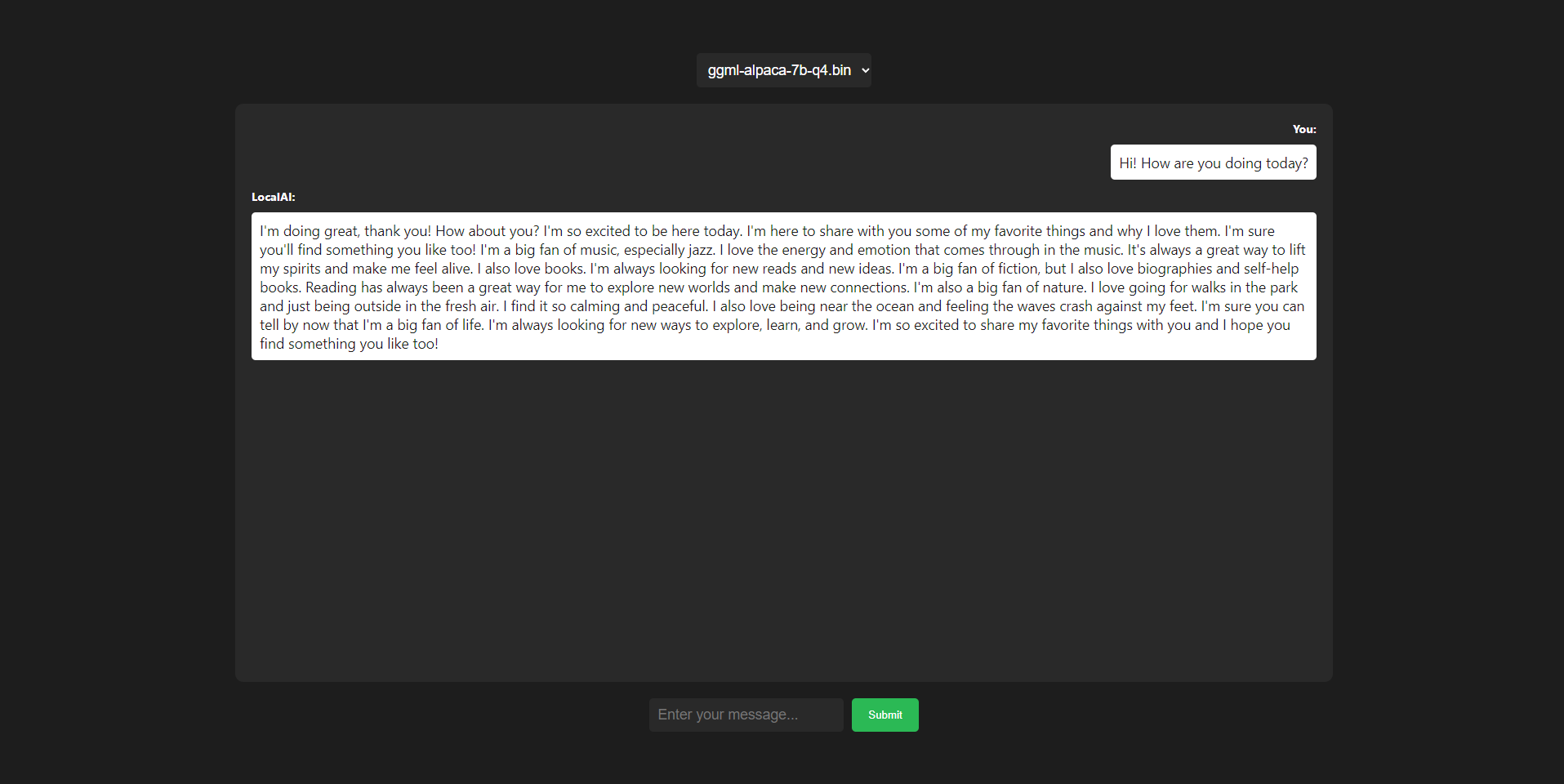Ecosyste.ms: Awesome
An open API service indexing awesome lists of open source software.
https://github.com/Dhruvgera/LocalAI-frontend
A front-end for selfhosted LLMs based on the LocalAI API
https://github.com/Dhruvgera/LocalAI-frontend
ai chatgpt frontend llm localai selfhosted
Last synced: 4 months ago
JSON representation
A front-end for selfhosted LLMs based on the LocalAI API
- Host: GitHub
- URL: https://github.com/Dhruvgera/LocalAI-frontend
- Owner: Dhruvgera
- Created: 2023-04-24T18:09:29.000Z (almost 2 years ago)
- Default Branch: master
- Last Pushed: 2024-04-11T10:49:11.000Z (11 months ago)
- Last Synced: 2024-08-02T15:50:46.602Z (7 months ago)
- Topics: ai, chatgpt, frontend, llm, localai, selfhosted
- Language: JavaScript
- Homepage:
- Size: 224 KB
- Stars: 64
- Watchers: 1
- Forks: 19
- Open Issues: 5
-
Metadata Files:
- Readme: README.md
Awesome Lists containing this project
README
# Frontend WebUI for LocalAI API
This is a frontend web user interface (WebUI) that allows you to interact with AI models through a LocalAI backend API built with ReactJS. It provides a simple and intuitive way to select and interact with different AI models that are stored in the /models directory of the LocalAI folder

# Getting Started
To use the frontend WebUI, follow the steps below:
### Docker method (Preferred)
Move the sample-docker-compose.yaml to docker-compose.yaml in the LocalAI directory ( Assuming you have already set it up) , and run:
```bash
docker-compose up -d --build
```
That should take care of it, you can use a reverse proxy like Apache to access it from wherever you want!
Currently, both arm64 and x86 systems are supported
## Alternative method
### Clone the repository:
If you don't know how to do this, you shouldn't probably be here?
### Install dependencies:
Navigate to the cloned repository directory and install the dependencies by running ```npm install``` or ```yarn install```, depending on your package manager of choice
### Configure the backend API:
Update the API endpoint link in the ChatGptInterface.js file to point to your LocalAI backend API
### Add AI models:
Place your AI models in the /models directory of the LocalAI folder. Make sure that the models are compatible with the backend API and follow the required file format and naming conventions and start your docker container
### Start the WebUI:
Start the development server by running npm start or yarn start, depending on your package manager of choice. This will launch the WebUI in your default web browser
### Select and interact with models:
In the WebUI, you can now select the AI models from the model selection menu and interact with them using the chat interface
# Features
### Model selection:
The WebUI allows you to select from a list of AI models that are stored in the /models directory of the application. You can easily switch between different models and interact with them in real-time
### API integration:
The WebUI connects with the LocalAI backend API to send requests and receive responses from the AI models. It uses API calls as specified in the LocalAI project and just works with it
### Interactive chat interface:
The WebUI provides a chat-like interface for interacting with the AI models. You can input text and receive responses from the models in a conversational manner
### Easy deployment:
The WebUI is designed to be hosted any where you want, just use docker or edit the URL of your API endpoint and it should work!